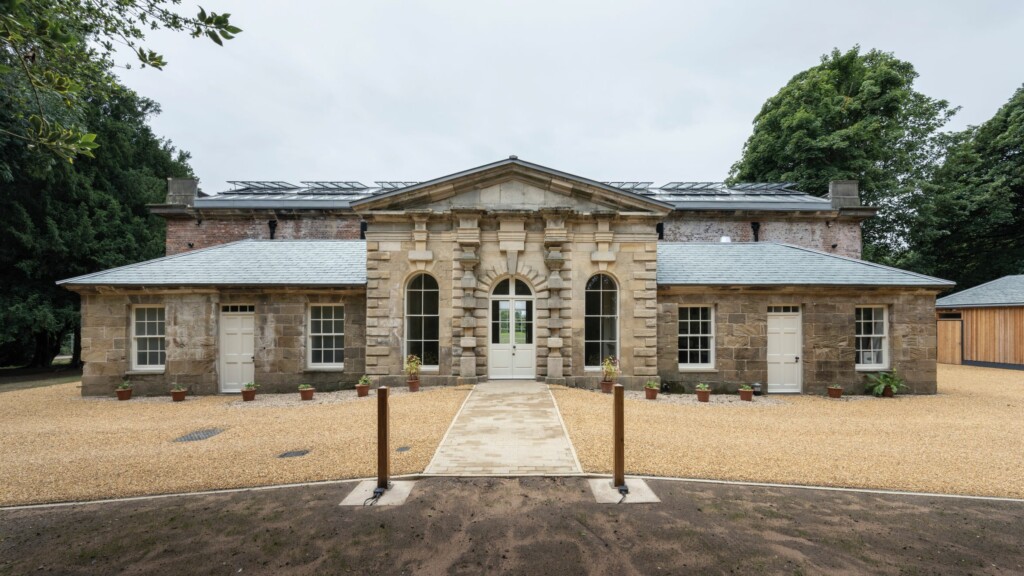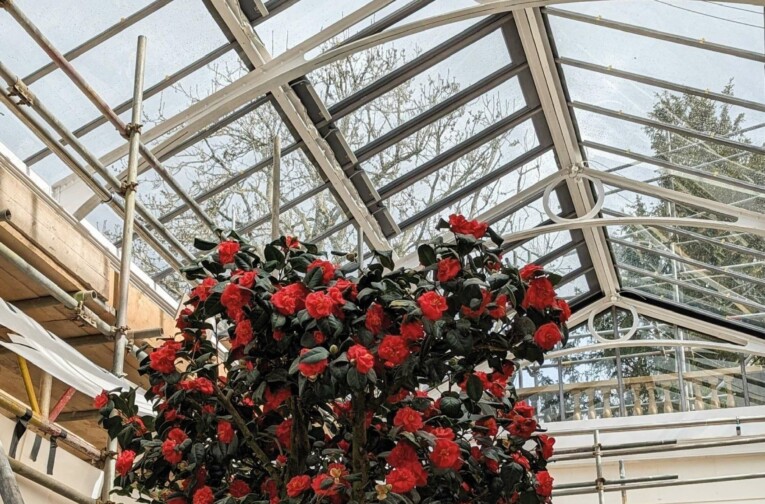From at-risk to Community Asset: Transforming the Camellia House
- | Dorian Proudfoot
Insall led the design team for Wentworth Woodhouse Preservation Trust (WWPT)’s successful multimillion-pound restoration of the Camellia House at Wentworth Woodhouse in South Yorkshire, carefully balancing the requirements of the heritage building with developing a sustainable energy strategy.
A lucky escape
The Camellia House is Grade II* listed. It’s a highly significant Georgian building and houses some of the rarest and oldest camellias in the Western world – cited by horticulturists as a “library full of first editions”. The Preservation Trust has inherited the surviving camellias, which have lived in the building undisturbed whilst it sat derelict for over 50 years following its lucky escape from open-cast coal mining in the 1950s. It eventually found itself on Historic England’s Heritage at Risk Register.
In 2020, the Preservation Trust secured £4m from the National Lottery Heritage Fund (NLHF) to restore the building and reimagine it as a tearoom and multipurpose venue. Helped by additional funding from Historic England and other charitable organisations and individuals, the £5m project was completed in July 2023.
Funding deadlines prompted an ambitious programme from the outset, with numerous challenges including its Grade II* listing, the severity of the decay to the building fabric, the proposed new use and the sensitivity of the priceless camellias which were to remain in situ throughout the project. We mobilised in January 2021, meeting with the core client team the first week after the Christmas break. We received and understood their brief and disseminated it to our 12-company strong sub-consultant team. The proposals were granted Listed Building Consent in Easter 2021.
How do we make a Georgian building sustainable and accessible?
The project’s mission was to bring the building back into use and remove it from Historic England’s Buildings at Risk Register whilst generating additional income for the Preservation Trust. The Trust was explicit that sustainability and universal access needed to be front and centre of this once-in-a-generation project.
The design team’s collective detailed survey of the building kickstarted the design discussion. Hand-drawn concept sketches explored natural ventilation principles, rainwater collection, renewable energy production and thermal upgrades. We gained an understanding of the existing fabric through collaboration, including an investigation into the remaining historic lime plaster around the camellias by the plaster conservators to establish if it was attached enough to the wall to be saved.
The conservation-accredited structural engineers and the timber specialists surveyed the timber and iron trusses to verify their condition and identify the necessary repairs. We produced information packages specifying the repairs and adaptations of the building and the surrounding landscape.
Reducing energy use: the technical detail
The Camellia House is primarily naturally ventilated to reduce energy levels. The large sash windows were carefully restored, coupled with opening roof lights in the new glass roof; cross and stack ventilation will provide natural ventilation in the summer and provide sufficient airflow for the camellia plants.
The underfloor heating works symbiotically with the thermal mass of the historic flagstone floors, avoiding significant energy demands whilst working in conjunction with the new ground source heat pumps. This new technology is the first to be installed at Wentworth Woodhouse and is a massive step towards the whole site, including the mansion, significantly lowering the building’s operational carbon emissions. The project also saw eight boreholes installed under the car park, which will provide sustainable ground source energy for future phases of development at the nearby Grade I-listed Stables.
Smart technology was introduced by way of climate-sensitive attenuators, which enable the roof lights to automatically operate in response to the internal climate. In addition, trench heating, fed by the ground source heat pump, has been introduced to reduce cold draughts, mitigate condensation and improve thermal comfort.
A rainwater harvesting system has been introduced to utilise natural rainwater camellia irrigation rather than treated mains water. The rainwater harvesting system is also used to flush the WCs in the building, reducing the reliance on mains water.
Nurturing the next generation
We believe in knowledge-sharing for a better future – in particular how we can adapt and reuse our existing building stock to help lower the built environment’s carbon emissions.
The project provided an opportunity to nurture the next generation of heritage craftspeople through a summer school, run by Historic England at Wentworth Woodhouse. This inaugural live-site training course in 2022 involved 19 trainees across various heritage crafts, from stone masons, joiners and bricklayers to roofers, stained glass conservators and millwrights. The apprentices spent eight weeks at Wentworth Woodhouse, helping to restore the Camellia House and the adjacent II* listed Ionic Temple.
We provided guidance in how to understand historical significance and explained the processes we go through to produce our repair specifications, followed by direction on site of the apprentices’ participation in repointing, stone cleaning, recording and relaying historic floors and sash window restoration.

Accessibility, social value and active travel
Providing universal access to the Camellia House was key to maximising public engagement and long-term sustainable use of the property. We created new level access throughout the public spaces and constructed a Changing Places facility within a new, contemporary designed timber-framed structure.
The Preservation Trust has entered into Labour Agreements with the Local Authority, ensuring local people benefit from the development through employment opportunities and skills improvement programmes. Additionally, we are encouraging active travel by delivering safe, inclusive and connected environments for walking, cycling and public transport. Electric vehicular charging points have also been installed.
The Camellia House has now been successfully removed from the Heritage at Risk register. The project was only possible thanks to the commendable dedication of our client team; collaboration with multiple subcontractors, specialist consultants and heritage organisations; a considerable team effort within our organisation across six of our studios at times. We hope that the ambitious in-use energy improvements and the high-quality conservation of the existing fabric will inspire heritage professionals to aim higher.
Read the full 2023 Review here
